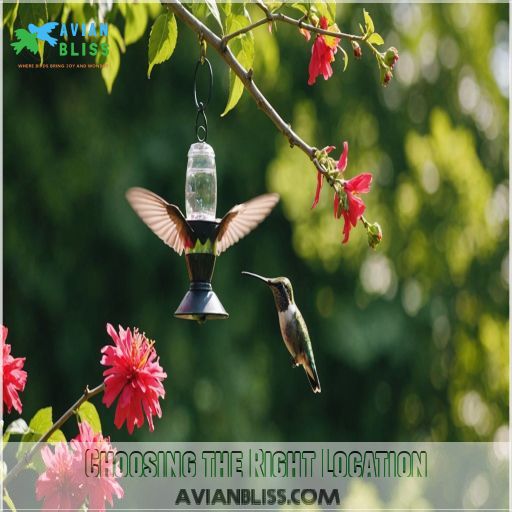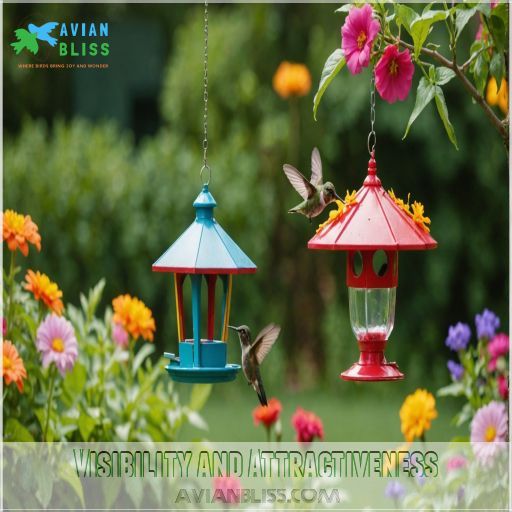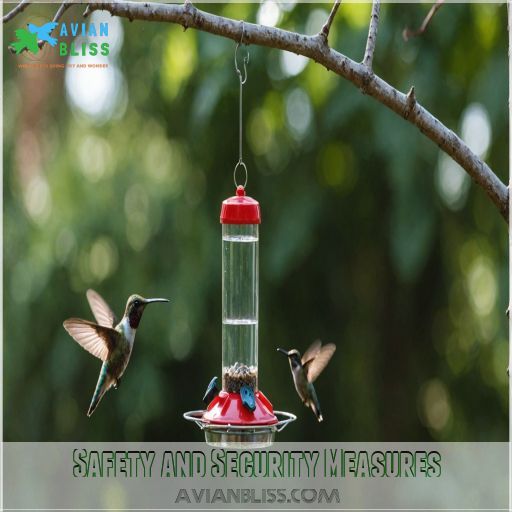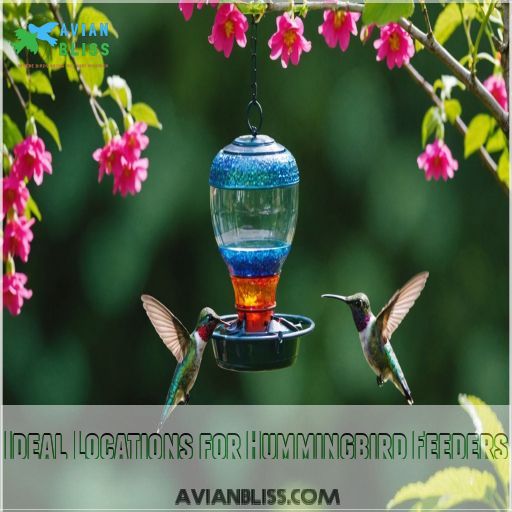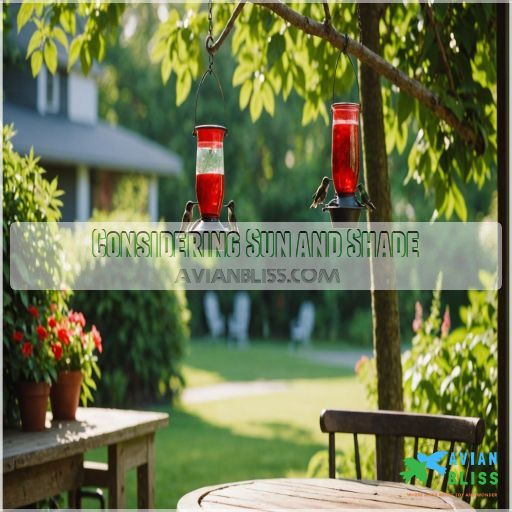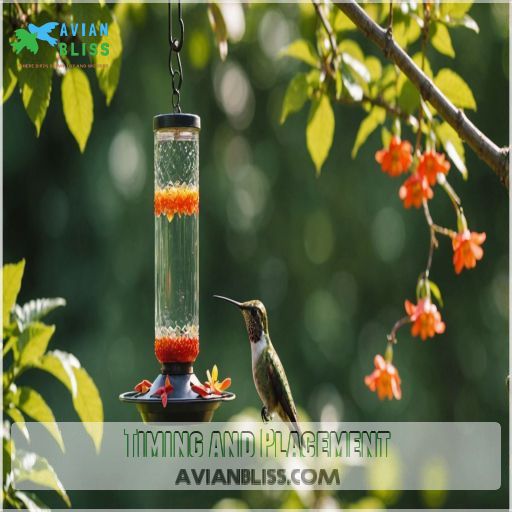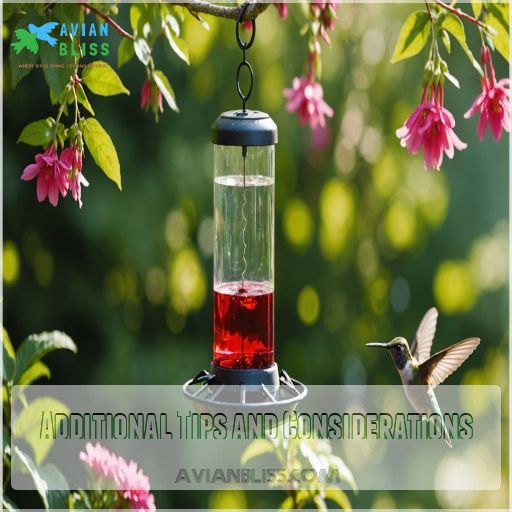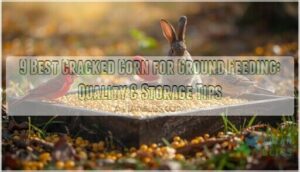This site is supported by our readers. We may earn a commission, at no cost to you, if you purchase through links.
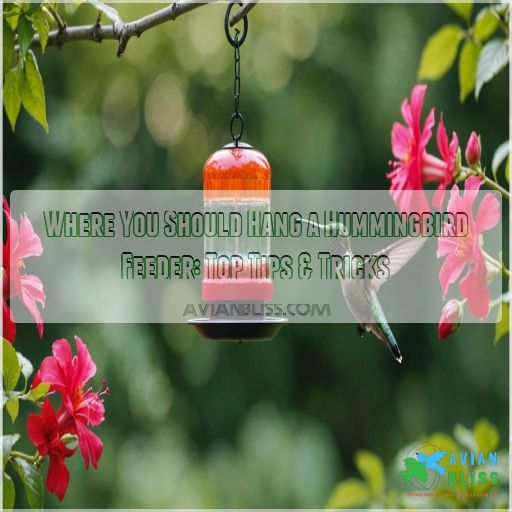
Position it high to keep curious cats and critters at bay, ideally in a spot that gets morning sun but afternoon shade (to keep the nectar from turning into soup).
Avoid the bustling areas—hummingbirds appreciate privacy, much like introverted celebrities.
For the best views, mount it near your window, but mind those glass collisions. Hint: there’s more to hummingbird happiness just around the corner, and the feeder’s positioning is key to providing the birds with a spot that gets morning sun.
Table Of Contents
- Key Takeaways
- Choosing the Right Location
- Visibility and Attractiveness
- Safety and Security Measures
- Providing a Safe and Private Space
- Ideal Locations for Hummingbird Feeders
- Considering Sun and Shade
- Proximity to Flowers and Vegetation
- Viewing and Observation
- Timing and Placement
- Additional Tips and Considerations
- Frequently Asked Questions (FAQs)
- Can you hang a hummingbird feeder near a bird feeder?
- Should a hummingbird feeder be hung high?
- Where should hummingbird feeders be placed?
- How far should hummingbird feeders be from the ground?
- Where should you not hang a hummingbird feeder?
- Where should hummingbird feeders be placed in sun or shade?
- How long does it take for hummingbirds to find their feeder?
- When should you put out hummingbird feeders in this area?
- How often should I change the nectar in the feeder?
- Can I use artificial coloring in the nectar?
- How do I keep ants out of the feeder?
- Can I feed hummingbirds year-round if they stay in my area?
- What are the best plants to grow to attract hummingbirds?
- Conclusion
Key Takeaways
- Position your hummingbird feeder in a spot that’s visible and accessible, like near windows or paths, so you can easily enjoy watching these tiny aerial acrobats.
- Hang the feeder within 10-12 feet of protective cover, such as trees or shrubs, to give hummingbirds a safe place to perch and retreat. This location should also provide the right balance of morning sun and afternoon shade to keep the nectar fresh.
- Choose a location that’s away from high-traffic areas and other bird feeders to prevent territorial conflicts and ensure your hummingbird guests feel comfortable and secure, keeping their clean feeder environments intact
.
- Keep your feeder clean and easily accessible for refilling to make it an inviting and reliable food source that hummingbirds will return to again and again.
Choosing the Right Location
Choosing the right location for your hummingbird feeder is important to attracting these tiny, high-energy birds.
From visibility and accessibility to safety and privacy, there are several key factors to keep in mind when finding the perfect spot to hang your feeder.
Consider Visibility and Accessibility
For the perfect hummingbird feeder location, visibility and accessibility are key. Choose a spot where both you and hummingbirds can enjoy the view.
- Place it near vibrant flowers to attract hummingbirds.
- Make sure it’s close to perching spots for rest.
- Avoid high-traffic areas for their peace.
- Position near windows for easy observation.
Enjoy hummingbirds flitting about!
Avoid Dense Foliage and Obstructions
Catch the eyes of these tiny aerial acrobats by ensuring hummingbird feeders are visible and free from dense foliage.
Position your feeders where colors can sparkle in the light, not hidden behind a leafy curtain.
It’s like giving them stage lights! Plus, open spaces let hummers hover safely, dodging predators and avoiding those pesky surprise encounters.
Place Near Decks, Patios, or Paths
Thinking about hummingbird feeder placement like near flowering plants and shrubs?
?
Let it shine near decks, patios, or paths. This way, you’re drawing birds safely, pleasing your deck design, and enhancing patio decor (Source).
- View: Keeps that precious feeder within sight, perfect for hummingbird watching.
- Safety: Makes sure hummingbird safety from predators.
- Landscaping: Complements path landscaping as a garden accent.
Ensure Easy Cleaning and Refilling
Imagine this: your hummingbird feeder perched in a perfect spot, accessible for easy cleaning and refilling! Find a location with a tap nearby to rinse and refill swiftly.
Consider these aspects:
| Hummingbird Feeder Types | Cleaning Frequency | Refill Intervals |
|---|---|---|
| Wide-mouth designs | Every few days | Weekly |
| Easy dissembles | Weekly | Bi-weekly |
| Anti-drip spouts | Hot weather: more | Every 3 days |
Happy hummingbird watching!
Visibility and Attractiveness
To make your hummingbird feeder irresistible, pick a spot that highlights its vibrant colors and reflections.
Add a splash of red to grab their attention.
They’ll appreciate morning sunshine to sparkle and afternoon shade as a cool refuge—just like a favorite hangout with the perfect ambiance.
Showcase Colors and Reflections
Great lighting can make a feeder irresistible to hummingbirds! Focus on maximizing reflection impact by placing your hummingbird feeder where sunlight enhances its colors.
Make sure:
- Feeder placement offers bright colors.
- Reflections capture hummingbird vision.
- Hummingbird nectar remains safe from bird predators like hawks, kestrels, and shrikes
.
- Feeder’s highly visible, attracting birds brilliantly.
Remember, a well-placed feeder’s like a dazzling beacon!
Use Red Colors to Attract Attention
Your hummingbird feeder’s vibrant red accents will instantly catch their eye as they zip through the sky.
Hummingbirds are naturally drawn to the bold, bright hue , so strategically placing red elements around the feeder will make it a beacon for these tiny, high-energy birds.
Ribbons, flowers, and even painted feeders can all lure hummingbirds to your yard with bold, bright colors.
Position in Areas With Morning Sunshine
Catch the morning sunshine with your hummingbird feeder by placing it on the east side of your house.
This position helps hummingbirds warm up and makes the nectar more visible, like a floral billboard calling to them.
Sunlight boosts visibility, enhancing the feeder’s appeal and ensuring these vibrant birds can easily find their mealtime haven , a position that is also known for making the nectar more visible, like a floral billboard calling to them and this happy situation is due to the fact that sunlight boosts visibility.
Provide Afternoon Shade for Comfort
To make sure your hummingbirds are comfortable, hang your feeder in a spot offering afternoon shade. Direct sunlight can ferment nectar, making it unappealing.
Trees can provide natural cover, creating a cozy oasis. Imagine sunbathing on a scorching day without shade—your feathered friends feel the same!
Choose shady areas in your bird feeding station for a healthier, happier hummingbird garden.
Safety and Security Measures
Finding the right spot for your hummingbird feeder is essential to keep these tiny visitors safe and secure while hanging it with fishing line tips
. Make sure it’s hung high enough to avoid cats but not so close to windows that they get startled by their own reflection—after all, even hummingbirds don’t enjoy a surprise head-butt!
Hang Feeders High to Prevent Predation
A feeder’s height is your frontline defense against any predator trying to spoil a hummingbird’s feast.
Here’s the lowdown:
- Hang feeders 5-6 feet high to deter cats and other wildlife.
- Keep a 12-foot buffer from bushes to eliminate predator cover.
- Add a sprinkling of fun with cat-deterring sprinklers!
Avoid Window Collisions and Strong Winds
If your hummingbird feeder is causing little feathered daredevils to crash into windows, try moving it to minimize reflections.
Place it either very close to the glass or far enough away that they won’t mistake it for open sky.
Also, shield your feeder from strong winds by using barriers like shrubs. This helps protect both their tiny wings and your windows.
The solution involves using a strategic placement to prevent hummingbirds from mistaking windows for open sky.
Protect Feeders From Rain and Contamination
Think of rain-resistant feeders as the superhero capes protecting hummingbird snacks from soggy messes.
Using feeder covers or creatively positioning them under eaves helps keep nectar fresh and tasty.
Regular cleaning routines and small feeding portals prevent contamination, ensuring your little aerial acrobats enjoy their sugary buffet without unwanted guests like ants, bees, or wasps intruding , and keeping the feeder free of soggy messes and unwanted guests.
Keep Feeders Away From High-Traffic Areas
Avoid placing your hummingbird feeder in high-traffic areas where it could get accidentally bumped or knocked over.
Busy walkways, play areas, or spots near pet bowls are prime spots for spills and leaks that can attract unwanted insects or predators.
Instead, choose a quiet, sheltered location away from heavy foot traffic for your feeder’s safety and the birds’ comfort.
Providing a Safe and Private Space
When hanging your hummingbird feeder, it’s essential to ensure it’s safe and private by keeping it away from larger birds.
This setup should provide ample space for these tiny aviators to zip around undisturbed. By setting up multiple feeders near protective cover, you’ll create a space that allows for aerial acrobatics.
Keeping enough room for these activities will help you create a hummingbird haven that’s both inviting and peaceful—more like a spa retreat than a chaotic buffet, offering a hummingbird haven.
Position Feeders Away From Other Birds
Hummingbird feeder placement can make a big difference in keeping your tiny guests safe and comfortable.
By hanging your hummingbird feeder away from other bird feeders, particularly near plants that attract unwanted bees, you’ll sidestep unnecessary bird feeder competition and give your feisty hummers some breathing room
.
These agile flyers prefer their own space to avoid aggressive birds and territorial behavior, ensuring a peaceful dining experience.
Distribute Multiple Feeders for Territorial Birds
Spread your feeders like little islands across your yard to dodge hummingbird aggression.
This spacing gives each hummer its own territory, reducing squabbles over sugar water.
Opt for feeder designs that cater to one bird at a time, minimizing conflicts.
Understanding bird behavior and territory size lets you enjoy a peaceful, vibrant garden filled with hummingbirds .
Place Feeders Near Protective Cover and Vegetation
Welcoming hummingbirds means offering safety and an escape route.
Place feeders near shrubs or trees, within 10-15 feet, to give them cover and predator protection .
A spot with both visibility and privacy is key. Think of it as their own secret café nook, hidden yet accessible—a sanctuary for these energy-saving jet-setters.
Choose garden layouts wisely!
Ensure Adequate Space for Maneuvering
Freedom in design helps you create safe feeding zones for hummingbirds.
Consider these three strategies:
- Spacing: Make sure feeders have ample room for hummers to navigate without bumping into obstacles. For example, you can use unique hummingbird feeders like the HighView HummZinger that features a high perch, providing extra space for hummingbirds to maneuver.
- Placement: Position feeders away from predators’ risks, such as cats or hawks, to reduce risks and create a safe environment for hummingbirds to thrive.
- Boundaries: Mind territorial instincts by providing enough feeders to minimize competition for resources, allowing multiple hummingbirds to feed simultaneously without conflicts.
Ideal Locations for Hummingbird Feeders
Choosing the perfect spot for your hummingbird feeder can feel like solving a puzzle.
But with the right location, you’ll create a buzzing oasis.
Hang it near nectar-rich blooms or your window for a delightful view.
And don’t forget some shade to keep the hums happy!
Hummingbird Gardens With Nectar-Rich Blooms
Planting a hummingbird garden with nectar-rich blooms is a surefire way to attract these tiny pollinators
.
Choose a variety of flowers that offer a continuous supply of nectar throughout the season, such as bee balm, columbine, and petunias.
Hummingbirds love the bright colors and tubular shapes that provide easy access to their favorite food.
Near Kitchen or Office Windows With Safety Measures
Placing your hummingbird feeder near a kitchen or office window offers great views.
Make sure to avoid window collisions for the birds’ safety. Choose a feeder design with suction cups and use window coverings like decals.
Proper feeder placement keeps hummingbirds safe while allowing you to marvel at their antics without worrying about bird safety issues.
Hang From Gutters, Awnings, or Gazebos
Hanging your hummingbird feeder from gutters, awnings, or gazebos offers a perfect blend of visibility and security.
It keeps the feeder accessible and conveniently shaded, ensuring nectar stays fresh without spoiling.
Plus, this position helps maintain aesthetics by integrating seamlessly into your outdoor decor.
Consider regular maintenance to prevent leaks and keep those hummingbirds coming back for more.
Position Within 10-12 Feet of Protective Cover
It’s really important to hang your hummingbird feeder within 10-12 feet of trees or shrubs, giving these zippy creatures a safe retreat.
Hummingbirds value quick escapes from potential predators. With some greenery nearby, they feel more secure while fueling up.
Think of it as setting up a cozy café with a view, where safety and refreshments meet harmoniously.
Considering Sun and Shade
When choosing a spot for your hummingbird feeder, aim for a balance of sun and shade.
Think of it like giving the birds a comfy lounge chair on a sunny beach—with an umbrella!
Morning sunlight attracts these energetic visitors, while afternoon shade keeps the nectar cool, inviting, and fresh.
Morning Sunshine for Visibility and Attractiveness
Morning sunlight is like a spotlight for hummingbird feeders, enhancing visibility and attractiveness through shimmering reflections.
When you place a feeder basking in morning rays, it draws in hungry hummers with eye-catching red hues.
This tip helps your hummingbird garden design maximize feeder visibility and leverage the benefits of the sun’s early glow.
Afternoon Shade for Comfort and Nectar Protection
When the summer heat kicks in, positioning your feeder in afternoon shade is like rolling out a red carpet for hummingbirds.
This shade placement helps hummingbird comfort and keeps nectar fresh as a daisy.
By shielding your feeder from harsh sunlight, you prevent it from becoming a hot nectar pot, keeping the delicacies cool and inviting for your tiny guests.
Dappled Shade Under Trees for Ideal Conditions
Dappled shade under trees offers the ideal conditions for your hummingbird feeder.
The filtered light keeps the nectar cool and fresh, while the natural perches allow these tiny birds to rest between sips.
Look for trees with:
- Moderate, evenly-distributed foliage
- Branches at the right height for easy feeder access
- Proximity to your viewing area
- Protection from strong winds
Avoid Direct Sunlight for Prolonged Periods
Imagine a sun-dappled zone like a cozy coffee shop for hummingbirds, where nectar stays fresh and inviting.
Avoid placing feeders in direct sunlight all day to prevent nectar spoilage and feeder overheating, which stresses our feathered friends.
Consider shade cloth options for hotter areas or place feeders under trees for natural relief.
Proximity to Flowers and Vegetation
When deciding where to hang a hummingbird feeder, think about the flowers in your garden that already bring hummingbirds joy.
Don’t let your feeder smother the crops, as hummers love having a wide berth for those fancy aerial acrobatics!
Place Feeders Near Existing Flowers That Attract Hummingbirds
As you consider sunlight’s role, remember to place feeders near blooms that attract hummingbirds.
Choose nectar-rich flowers like azaleas and petunias, which can guide these feathered friends to your feeder.
It’s like rolling out the red carpet with compatible species.
With a well-planned garden design, your hummingbird guests will be buzzing back for more sweet nectar!
Avoid Direct Contact With Vegetation for Hovering Space
To make sure hummingbirds have ample room to hover, keep feeders away from dense vegetation. Think of it as giving them their own runway.
Position your feeder so it has at least a foot of clear airspace around it, similar to the space needed around a hummingbird’s natural food corridor.
This setup prevents collisions with plants but also keeps the nectar clean and fresh for your tiny visitors.
Consider Adding Hummingbird Flowers With Varying Bloom Times
Hummingbird-friendly gardens thrive with flower types that bloom in various stages, ensuring nectar’s always on the menu.
Think of your garden as a rotating buffet with vibrant colors and tubular shapes that attract hummingbirds, like bee balm or columbine.
This adds charm but also diversity in bloom time keeps these "flying jewels" consistently.
Create a Hummingbird-Friendly Garden Environment
Inject a burst of color into your garden design with vibrant hummingbird plants and varied nectar sources. Remember, though, hummingbirds hate surprises—like a predator threat! Keep feeders safe by monitoring them closely and maintaining cleanliness.
- Mix reds, blues, and purples for irresistible allure.
- Spread plants for hummingbird hover room.
- Make sure feeder maintenance for ongoing visits.
Viewing and Observation
Positioning your hummingbird feeder near good viewing windows or areas with unobstructed views allows you to create an immersive hummingbird-watching experience.
Consider adding benches or a cozy gazebo nearby to enjoy the show in comfort.
Position Feeders Near Good Viewing Windows
Peek at the buzzing ballet! Mount your feeder near a window—it’s like theater with a feathered cast.
Consider bird behavior and safety concerns by keeping the feeder design in mind to prevent collisions.
Handy table time:
| Aspect | Consideration |
|---|---|
| Window | Placement |
| Safety | Concerns |
| View | Angles |
| Feeder | Design |
| Bird | Behavior |
Enjoy the show!
Place Feeders in Areas With Unobstructed Views
When choosing a spot for your hummingbird feeder, visibility is key. Place it where you can enjoy the show.
Remember bird safety; keep it away from windows to prevent collisions. Make sure there’s a wide view and it’s not hidden among branches.
You’ll soon have tiny acrobats visiting, so keep the feeder clean for them.
Consider Benches or Gazebos for Comfortable Viewing
There’s nothing like a peaceful spot for hummingbird viewing from a gazebo or bench.
Choose a location in your garden where you can enjoy these fascinating birds up close. Make sure you have comfortable seating to make birdwatching a delightful pastime.
Whether it’s Beatty’s Guest Ranch or a local park, you’ll love the calming presence of hummingbirds (Source), .
Create a Hummingbird-Watching Experience
After setting up comfy seating, create a hummingbird-watching experience to let your mind’s wings unfold. A world of hummingbird behavior awaits, like aerial acrobats dazzling with designs, while feeding.
To attract these birds, position your feeder near foliage, like dense trees or shrubs, providing them with proximity for perching and nesting, as this creates an inviting oasis. Also, consider the sunlight, as it prevents nectar from fermenting too quickly, reducing cleaning needs.
Try DIY feeders for a personal touch or capture whimsical moments with photography.
- Use garden design to blend feeders naturally
- Make sure feeders have a splash of red
- Set early morning alarms for the best viewing
Timing and Placement
Hanging your feeders in the summer, when hummingbirds are most active, helps you attract them to your yard.
Keep an eye on migration patterns and feeder activity, and you’ll soon be the host of a buzzing diner for these tiny, energetic guests.
Hang Feeders in Summer Months for Optimal Visibility
In summer, hang your hummingbird feeder for the best visibility and joy. Consider vibrant feeder types and tasty summer nectar recipes for attraction.
Keep it clean to entice visitors. Placing feeders smartly for easy access and perfect viewing lets these tiny travelers brighten your day.
| Tip | Details |
|---|---|
| Feeder Types | Use bright colors |
| Nectar Recipe | 1 part sugar, 4 parts water |
| Cleaning Tips | Refresh every 2-3 days |
| Placement | Near flowers, visible area |
| Viewing Pleasure | From windows or porches |
Consider Local Hummingbird Migration Patterns
When planning where to hang your hummingbird feeder, be mindful of the local migration patterns. Hummingbirds typically arrive in the southern United States as early as February, with the northernmost regions seeing them in late spring. (Source) Use migration maps to estimate when they’ll reach your area, so you can have your feeder ready to welcome them.
- Ruby-throated hummingbirds gather in the Gulf Coast states in September before their journey south.
- Rufous hummingbirds head south via the Rocky Mountains.
- Timing your feeder placement based on regional migration patterns makes sure these tiny travelers have a reliable food source when they need it most.
Monitor Feeder Activity and Adjust Placement as Needed
Now that you’re aware of hummingbird migration patterns, keep an eye on feeder activity.
Notice changes in bird count to decide if relocation’s needed. Maybe your feeder’s in a sunburnt alley or a sneaky cat’s lurking nearby.
Humorously, think of yourself as a detective! Regularly cleaning and adjusting based on hummingbird behavior can boost visits, helping you become a successful detective.
Provide a Consistent Food Source for Hummingbirds
Keep your hummingbird feeders stocked to please these energetic fliers. Monitor feeder activity and stay one step ahead of empty feeders.
Maintain a fresh nectar supply by:
- Preparing a simple nectar recipe: 1 part sugar to 4 parts water.
- Cleaning and refilling feeders twice weekly.
- Placing feeders in shaded areas to prevent spoilage.
Additional Tips and Considerations
Don’t hang feeders in barren areas where hummingbirds might feel exposed, or near your pets that could scare them off.
Keep your feeders shielded from strong winds and rain.
Make sure they’re easy to reach for cleaning and refilling—your future self will thank you, especially for considering your future self.
Avoid Hanging Feeders in Barren or Open Areas
Don’t hang your hummingbird feeders in barren or open areas where they’ll feel as exposed as a celebrity without shades.
Birds watch for predators and avoid spots that scream, "Welcome, hawks!"
Nestle feeders near natural cover like trees or shrubs, but mind the distance—10 to 12 feet is ideal for both visibility and predator protection.
Keep Feeders Away From Pet Areas and Predators
Creating a pet-friendly yard starts with strategic hummingbird feeder placement.
Protect these aerial acrobats from curious critters:
- Position feeders away from cats and dogs.
- Hang them 12 feet from shrubs to deter stealthy predators.
- Elevate feeders on poles with predator guards.
- Provide nearby escape routes, like trees, for quick retreats.
Your hummingbirds will thank you!
Try to Protect Feeders From Strong Winds and Rain
Weatherproofing your hummingbird feeder starts with smart feeder placement.
Find a sheltered spot close to your home, out of the wind’s wrath, and under an overhang to dodge rain.
Opt for a durable feeder design—think tempered glass or metal—for extra protection.
This thoughtful setup keeps your hummingbirds happy and dry, even when storms roll in.
Ensure Feeders Are Convenient to Refill and Clean
Hang your feeder where you can easily access it for quick refills.
A wide-mouth design and detachable parts make this a breeze.
Position the feeder at eye level for convenient monitoring and maintenance.
Cleaning just takes a few minutes, but it’s essential for keeping your hummingbird visitors happy and healthy. A key part of this process is ensuring the feeder is thoroughly cleaned, which helps maintain the quick refills and overall well-being of the birds.
Frequently Asked Questions (FAQs)
Can you hang a hummingbird feeder near a bird feeder?
While you can position a hummingbird feeder near a bird feeder, it’s generally best to keep the two separated.
Hummingbirds tend to be aggressive and may avoid feeding if larger birds are nearby.
Should a hummingbird feeder be hung high?
No, you don’t want to hang the hummingbird feeder too high.
Aim for 5-6 feet off the ground – high enough to deter predators, but low enough for the hummingbirds to feel comfortable feeding.
Where should hummingbird feeders be placed?
Hummingbirds are on a neverending quest for nectar bliss, my friend!
The secret to luring these high-octane avian marvels is to position your feeder like a pro.
Just 10-15 feet from cover for maximum comfort and visibility.
How far should hummingbird feeders be from the ground?
Ideally, hang hummingbird feeders 5-6 feet off the ground. This elevation provides a comfortable feeding height for the birds while keeping them safe from predators on the ground.
Where should you not hang a hummingbird feeder?
Steer clear of precarious spots, dear friend – we wouldn’t want those petite aviators in a pickle!
Opt for secure, shaded sanctuaries that let them feast in peace.
Free from pesky predators or unwanted guests.
Where should hummingbird feeders be placed in sun or shade?
Place your hummingbird feeder in a partially shaded area, about 10-15 feet from cover like trees or shrubs.
This offers the birds protection, while still allowing them to spot the feeder easily.
How long does it take for hummingbirds to find their feeder?
It typically takes 1-2 weeks for hummingbirds to find a new feeder in your yard.
You can draw them in faster by using a bright red feeder and keeping it clean and filled with fresh nectar.
When should you put out hummingbird feeders in this area?
Fun fact: Hummingbirds can detect food sources up to a mile away!
The best time to put out your feeders is the last week of April or the first week of May.
Keep them filled and cleaned weekly to attract these energetic visitors all summer long.
How often should I change the nectar in the feeder?
You’ll want to change the nectar in your hummingbird feeder every 2-3 days during hot weather, and once a week during milder conditions.
to keep the nectar fresh and prevent spoilage.
Can I use artificial coloring in the nectar?
Avoid using artificial coloring in hummingbird nectar.
The dyes can be harmful to these tiny birds, potentially exposing them to 17 times the accepted daily intake for humans.
Stick to a simple sugar water mixture instead, avoiding the potential harm caused by artificial coloring.
How do I keep ants out of the feeder?
Keep ants at bay with a few smart tricks.
Hang the feeder over water using fishing line, install an ant moat, and relocate it frequently.
This’ll stop those pesky critters from raiding your hummingbird’s sweet nectar.
Can I feed hummingbirds year-round if they stay in my area?
If hummingbirds remain in your area year-round, you can absolutely keep their feeders up all year. These tiny dynamos need a steady supply of nectar to fuel their high-octane metabolisms.
What are the best plants to grow to attract hummingbirds?
Studies show that when nectar-rich flowers are abundant, hummingbirds are less likely to visit feeders.
So fill your garden with colorful, tubular blooms like bee balm, petunias, and cardinal flowers for a hummingbird-friendly oasis.
Conclusion
Imagine a hummingbird sanctuary in your own backyard – a spot that lets these vibrant acrobats soar gracefully without hazards.
By positioning your feeder in the right location with morning sun, afternoon shade, and nearby foliage, you can create a safe, serene space where hummingbirds thrive.
The perfect place to hang a hummingbird feeder is one that combines visibility, accessibility, and thoughtful consideration for the birds’ needs.
With these tips, you’ll soon be delighting in the amazing dance of nature’s smallest performers, and enjoying the company of these vibrant acrobats.

